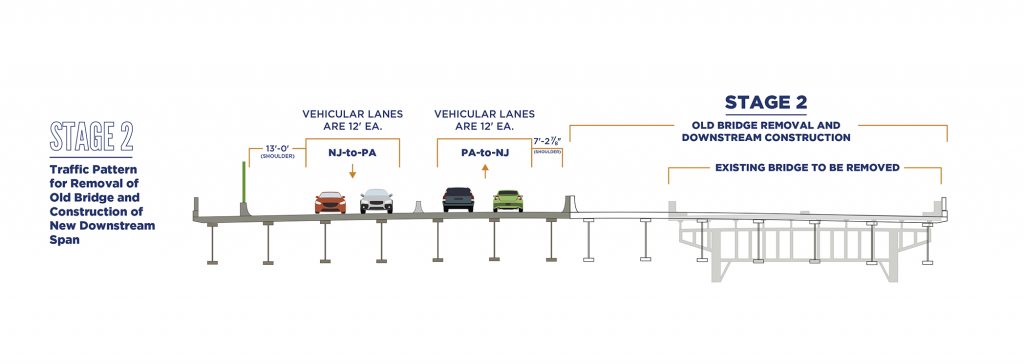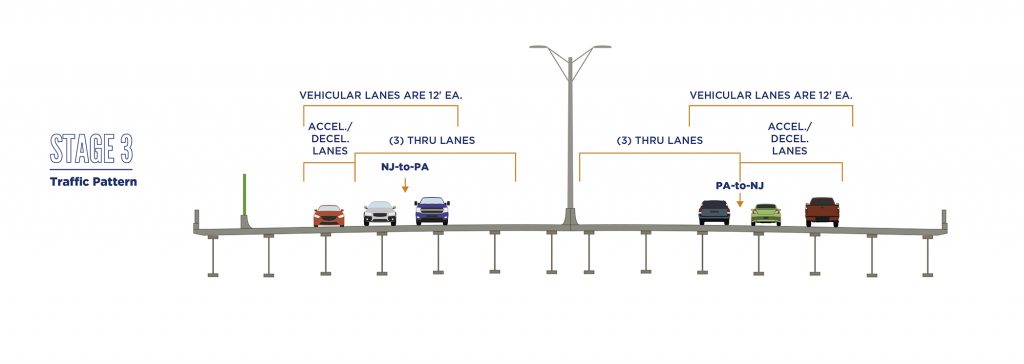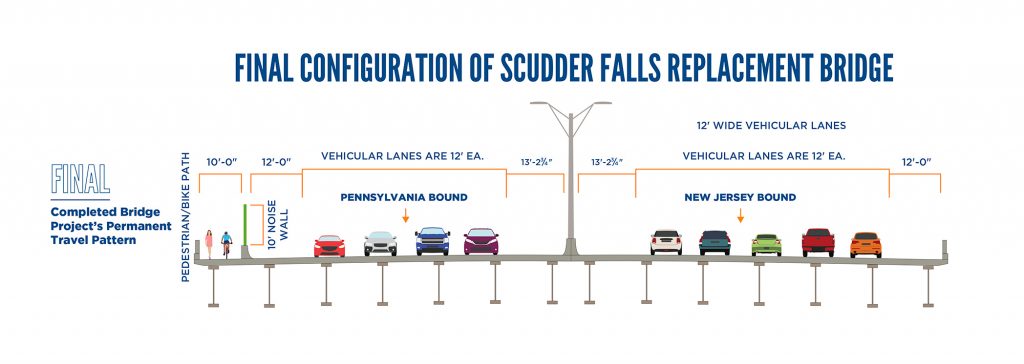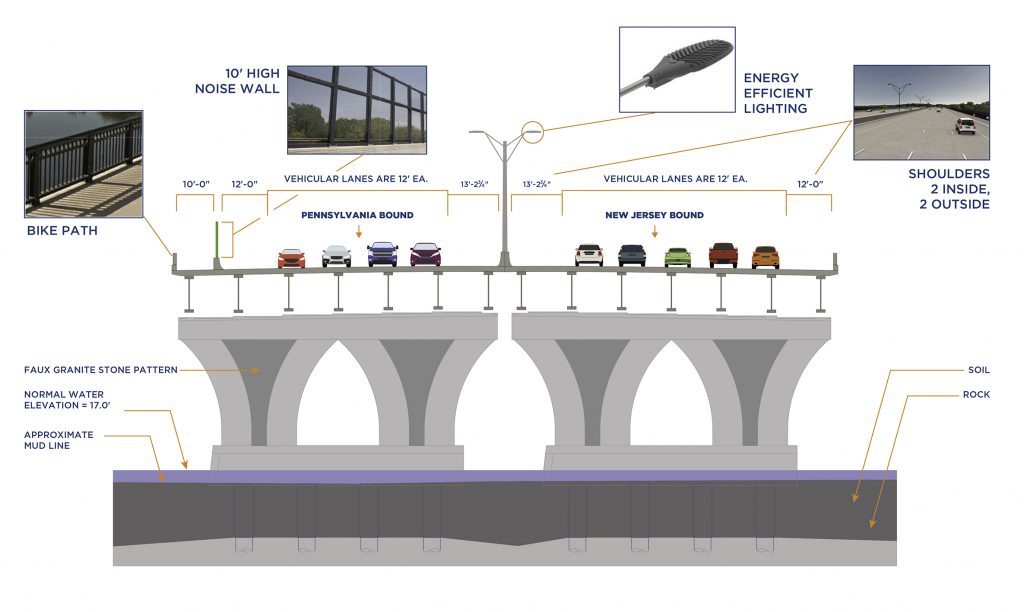Scudder Falls Bridge Replacement Project
Project Overview
This five-year-long project reached substantial completion Dec. 17, 2021 and final completion on October 31, 2022. The project area extended 4.4 miles along I-95 between the PA Route 332 (Newtown-Yardley Road) Interchange (Exit 8) in Pennsylvania and the Bear Tavern Road (County Route 579) Interchange (Exit 75) in New Jersey. The centerpiece element of the project was the replacement of a nearly 60-year-old “functionally obsolete” riveted plate-girder bridge that had fracture-critical pins and hangers. The new crossing is a dual-structure continuous multi-girder steel bridge with increased through-traffic capacity, auxiliarly lanes for accelerating/decelerating traffic at flanking interchanges, shoulders, and a shared-use (pedestrians and bicyclists) walkway.
Have Questions?
Call the Commission’s customer service line: 1-800-363-0049
or click here for the Commission’s Contact form
Project Information
Project in a Nutshell
All long-term project-related travel restrictions ended with the achievement of substantial completion on Dec. 17, 2021. Final completion of the project was reached October 31, 2022.
The project was carried out in three stages:
- Stage 1 centered on construction of the first span of the new bridge immediately upstream of the former neary-60-year-old Scudder Falls Bridge. The completed upstream span was phased into service in July 2019 along with an all-electronic tolling (AET) facility on the Pennsylvania side of the bridge. Highway interchange reconstruction/reallignment work also was performed at each end of the bridge during this stage.
- Stage 2 began around the time the first completed span went into service. This work involved demolition of the former functionally obsolete bridge and construction of the new Scudder Falls Toll Bridge’s second span. Highway widening and other upgrades and interchange improvements also were completed during this stage. This stage ended with the opening of the second span in August 2021.
- Stage 3 began in August 2021 and ended with the project reaching substantial completion on December 17, 2021. The final lane and shoulder configurations for the project area were completed at this time, whith the first span (upstream) carrying only Pennsylvania-bound traffic and the second span (downstream) carrying only New Jersey-bound traffic.
- All punch-list work was completed during the first 10 months of 2022 and final completion was declared October 31, 2022.
Preparations for the project were initiated in early 2003 and culminated with the June 14, 2012 issuance of a pivotal Finding of No Significant Impact (FONSI) from the Federal Highway Administration (FHWA). The FHWA’s determination validated the project’s extensive environmental documentation (Environmental Assessment and Addendum to the Environmental Assessment) compiled by the Delaware River Joint Toll Bridge Commission and its project management team.
Note: A concise memo on the traffic diversion findings in the EA Addendum may be viewed here.
With the FHWA’s action in 2012, project preparations shifted to updating of project right-of-way plans, identification and execution of priority work items in anticipation of design and construction, and delivery of retrieved unearthed archaeological materials to state museums in Harrisburg and Trenton.
The Commission formally moved the project into the final design phase in early 2015. This action followed the completion of a system-wide investment-grade (Level III) traffic and revenue study in 2014 and a reconfirmation that the project would be executed as a conventional design-bid-build project.
The program cost of the project was $534 million. (This figure represents the all-in cost and includes construction, concept plans, final design, environmental documentation and all other previous and projected expenditures.)
The project involved much more than a replacement of the current functionally obsolete four-lane Scudder Falls Bridge. The project also included safety upgrades to the two highway interchanges at both ends of the bridge, widening of the approach highway (formerly signed I-95 but switched to I-295 for reasons unrelated to the project) from the bridge to Route 322 in Pennsylvania, and construction of shoulders on the bridge crossing to handle breakdowns and emergencies. The two inside shoulder lanes would have the capacity to serve proposed bus/rapid transit routes. A shared-use bike/pedestrian walkway was constructed on the bridge’s upstream side to connect canal paths on both sides of the river. Also noise-abatement walls were installed where warranted in the project area.
The project’s main elements were as follows:
- Widen I-95 (later I-295) in Pennsylvania from PA 332 to the inside by adding one travel lane in each direction through utilization of the current grass median along that roadway stretch.
- Reconfigured the Taylorsville Road Interchange in Lower Makefield Twp., Pa. by eliminating the existing eastern southbound off-ramp from I-95 and combining it with the existing western southbound off-ramp. All other existing ramps at the interchange — the northbound off-ramp, the two northbound on-ramps, and the southbound on-ramp — were retained with various alignment modifications. This work was enhanced by other improvements, including installations of extended acceleration and deceleration lanes to improve traffic safety and flowat the interchanges and the bridge.
- Replaced the former outdated four-lane Scudder Falls Bridge with an entirely new dual-span structure. The new bridge carries six lanes of through traffic (three in each direction) with two auxiliary New Jersey-bound lanes for entry/exit travel at nearby interchanges and one auxiliary Pennsylvania-bound lane for entry/exit travel between nearby interchanges. The new bridge also has full inside and outside roadway shoulders, as required by federal design standards.
- A bicycle and pedestrian facility opened November 2021 on the north side of the bridge’s upstream span.
- Reconstructed and reconfigured the Route 29 interchange through the use of roundabouts. This option avoids traffic signals and encourages safe movements of vehicles between I-295 and Route 29. Bypass lanes for NJ Route 29 northbound and southbound traffic were retained and improved acceleration and deceleration lanes were provided onto and off of I-295. The notorious stop-sign at the on-ramp from the interchange to the bridge was eliminated.
In December 2009, the Commission voted to establish cashless tolling for the Scudder Falls Replacement Bridge. The action was taken due to the absence of federal and state transportation support for the project.
Tolling at the new bridge will be conducted through an “all-electronic tolling” (AET) system. A conventional barrier toll plaza will not be built. AET allows motorists to travel at prevailing speeds without having to stop to pay the toll. Non-E-ZPass-equipped vehicles passing through the cashless toll system will be subject to video capture by the camera equipment mounted on an overhead gantry; the DRJTBC will send a bill to the vehicle’s registered owner to collect the Toll-by-Plate toll. Tolls for E-ZPass customers will be lower than the rates for Toll-by-Plate customers, which will have higher administrative costs. (To see the approved toll schedule for the new bridge, please the tolling page in the documents section of the Scudder Falls Bridge Replacement Project’s website — www.scudderfallsbridge.com. The page may be directly accessed here. It is scheduled take effect when the first span of the new bridge opens to traffic in early 2019.)
Tolling will be in the southbound direction only (entering Pennsylvania). This one-direction toll collection is consistent with all other DRJTBC toll bridges where tolls are charged for traffic crossing from New Jersey to Pennsylvania.
Tolling at the Scudder Falls Replacement Bridge ensures that its users shoulder the cost burden of the project’s significant transportation-infrastructure and safety improvements.
- Archaeological Investigations: Programmatic Agreement
- Archaeological Investigations: Data Recovery Reports
- Finding of No Significant Impact
- Final 4(f) Evaluation
- Addendum to the Environmental Assessment
- Biological Opinion from National Marine Fisheries Services (NMFS)
- Environmental Assessment/Draft Section 4(f) Evaluation (EA)
- Biological Assessment
- Final Level III Traffic Study
- Pre-Construction Traffic Study
- Executive Summary
- Appendix A – Traffic Counts
- Appendix B – Turning Movement Counts
- Appendix C – Automatic Traffic Recorder Counts
- Appendix D – Automatic Traffic Recorder Count Figures
- Appendix E – Intersection Field View Sheets
- Appendix F – Segment Field View Sheets
- Appendix G – Signal Plans
- Appendix H – Capactivy Analysis Worksheets (Intersections)
- Appendix I – Capacity Analysis Worksheets (Freeways)
- Appendix J – Capacity Analysis Worksheets
- Appendix K – Capacity Analysis Worksheets (Urban Streets)
- Appendix L – Capacity Analysis Worksheets (Two-Lane Roadways)
- Appendix M – Capacity Analysis Worksheets (Multi-Lane Roadways)
- Level III Traffic Study
- Technical Memo No. 28 – Final Point of Access Study
- Final Study
- Appendix A -Figures
- Appendix B – Design Criteria
- Appendix C – NJ Route 29 Interchange Roundabout Evaluation Study
- Appendix D – Point of Access Signing Plans
- Appendix E – 2004 Crash Report
- Appendix F – DVRPC Traffic Study (2004)
- Appendix G – Estimated Diversion Volumes Graphic and Tablet
- Appendix H – Taylorsville Road Analysis
- Appendix I – I-95 Mainline Analyses
- Appendix J – NJ Route 29 Roundabout Analysis
- Appendix K – Estimated Volume to Capacity Ratios on Area Roadways
- Scudder Falls Bridge Traffic Diversion Study – Revised Final Report
VIEW COMPLETED PROJECT VIDEO
Project Elements
Construction Schedule
| 2017 | 2018 | 2019 | 2020 | 2021 | 2022 |
|
S1
|
|
| Stage 1 (Completed; Upstream Span Opened July 9, 2019) Upstream span constructed, PA approach widened, flanking interchanges reconfigured/reconstructed; All-Electronic Tolling began July 14, 2019 |
|
|
|
S2
|
|
| Stage 2 (July 2019-August 17, 2021) Old bridge demolished, downstream span constructed, shared-use path on upsream span completed |
||
|
|
S3
|
|
| Stage 3 (Fall 2021) Traffic moved to outside lanes on completed bridge spans for set up of final travel patterns, final paving applied through project area |
||
|
|
FS
|
|
| Final Stage (December 2021 to October 31, 2022) All lanes open through project area while punch-list work was completed to close out the project |
||
The Delaware River Joint Toll Bridge Commission’s contractor (Trumbull Corporation) carried out project construction with traffic moving across the river at all times. To achieve this, project construction was designed to be executed in four major stages.

